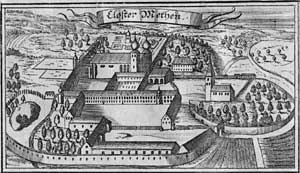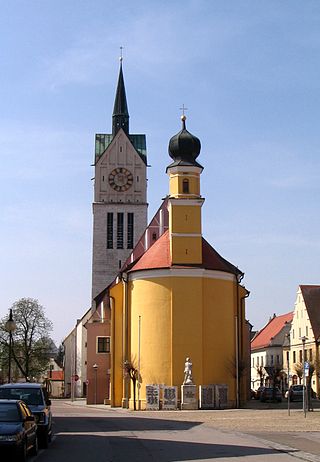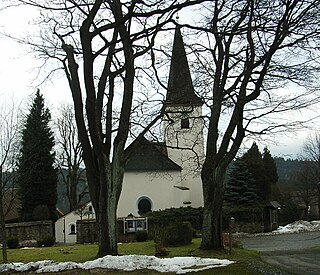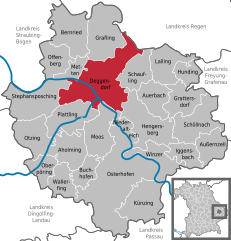
Abensberg is a town in the Lower Bavarian district of Kelheim, in Bavaria, Germany, lying around 30 km (19 mi) southwest of Regensburg, 40 km (25 mi) east of Ingolstadt, 50 km (31 mi) northwest of Landshut and 100 km (62 mi) north of Munich. It is situated on the river Abens, a tributary of the Danube.

Franconia is a region of Germany, characterised by its culture and East Franconian dialect. Franconia is made up of the three Regierungsbezirke of Lower, Middle and Upper Franconia in Bavaria, the adjacent, Franconian-speaking South Thuringia, south of the Thuringian Forest—which constitutes the language boundary between Franconian and Thuringian—and the eastern parts of Heilbronn-Franconia in Baden-Württemberg.

Regensburg is a city in eastern Bavaria, at the confluence of the Danube, Naab and Regen rivers, Danube's northernmost point. It is the capital of the Upper Palatinate subregion of the state. With more than 150,000 inhabitants, Regensburg is the fourth-largest city in the State of Bavaria after Munich, Nuremberg and Augsburg and the 8th largest of all cities on the Danube river. From its foundation as an imperial Roman river fort, the city has been the political, economic and cultural centre of the surrounding region. Later, under the rule of the Holy Roman Empire, it housed the Perpetual Diet of Regensburg.

Landshut is a town in Bavaria in the south-east of Germany. Situated on the banks of the River Isar, Landshut is the capital of Lower Bavaria, one of the seven administrative regions of the Free State of Bavaria. It is also the seat of the surrounding district and has a population of more than 75,000. Landshut is the largest city in Lower Bavaria, followed by Passau and Straubing, and Eastern Bavaria's second after Regensburg.

Fürth is a city in northern Bavaria, Germany, in the administrative division (Regierungsbezirk) of Middle Franconia.

Dillingen or Dillingen an der Donau is a town in Swabia, Bavaria, Germany. It is the administrative center of the district of Dillingen.

Bavarians are an ethnographic group of Germans of the Bavaria region, a state within Germany. The group's dialect or speech is known as the Bavarian language, native to Altbayern, roughly the territory of the Electorate of Bavaria in the 17th century.

Neuburg an der Donau is a town which is the capital of the Neuburg-Schrobenhausen district in the state of Bavaria in Germany.

Cham is the capital of the district of Cham in the Upper Palatinate in Bavaria in Germany.

Metten Abbey, or St. Michael's Abbey at Metten is a house of the Benedictine Order in Metten near Deggendorf, situated between the fringes of the Bavarian Forest and the valley of the Danube, in Bavaria in Germany.

Neustadt an der Donau is a town in Lower Bavaria on the Danube in Bavaria, Germany. Lying on the western border of Landkreis Kelheim, Neustadt is primarily known for the thermal spa Bad Gögging. Neustadt had a population of 12,753 as of December 31, 2003.

Röttingen is a town in the district of Würzburg, in Bavaria, Germany. It is situated 30 kilometres (19 mi) south of Würzburg, and 15 kilometres (9 mi) east of Bad Mergentheim.

Lalling is a municipality in the Lower Bavarian district of Deggendorf in Germany. It is a nationally recognized resort town.

Saal is a municipality in the district of Kelheim in Bavaria in Germany. It is located along the banks of the Danube River, around 25 km southwest of Regensburg.

Floß is a market town in the Upper Palatinate district of Neustadt an der Waldnaab and has a history of more than 1000 years.

Stadlern is a municipality in the district of Schwandorf in Bavaria, Germany.
The Landesliga Bayern-Mitte was the sixth tier of the German football league system in southern Bavaria. Until the introduction of the 3. Liga in 2008, it was the fifth tier of the league system, until the introduction of the Regionalligas in 1994 the fourth tier.
The Royal Bavarian Eastern Railway Company or Bavarian Ostbahn was founded in 1856. Within just two decades it built an extensive railway network in the eastern Bavarian provinces of Upper Palatinate (Oberpfalz) and Lower Bavaria (Niederbayern) that had previously been largely undisturbed by the railway. Much of this network is still important for local and long distance rail traffic operated by the Deutsche Bahn today.

The Bavarian Forest Railway links the heart of the Bavarian Forest around Regen and Zwiesel to Plattling and the Danube valley on one side, and the Czech Republic through Bayerisch Eisenstein on the other. In the Danube valley it forms a junction with the Nuremberg–Regensburg–Passau long-distance railway and, to the south, regional lines to Landshut and Munich.
Joseph Hanisch was a Bavarian, Roman Catholic organist and conductor. Hanisch was based in Regensburg from 1829 until his death in 1892.






















